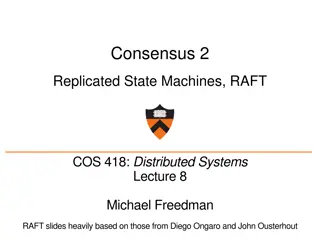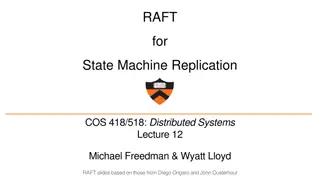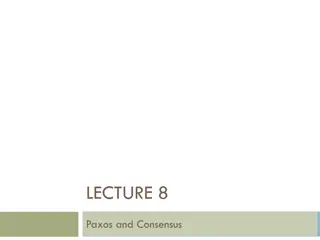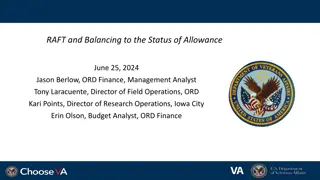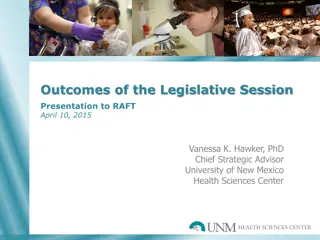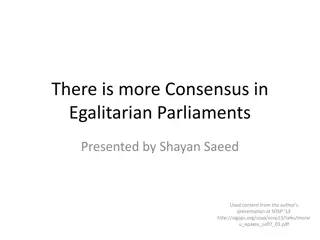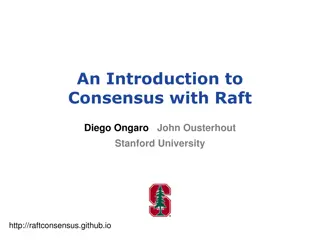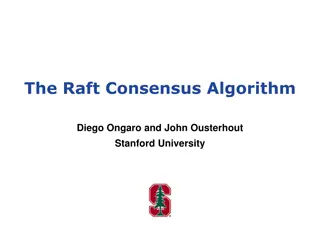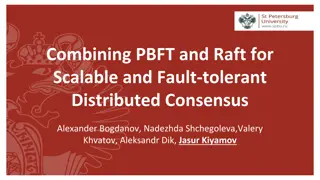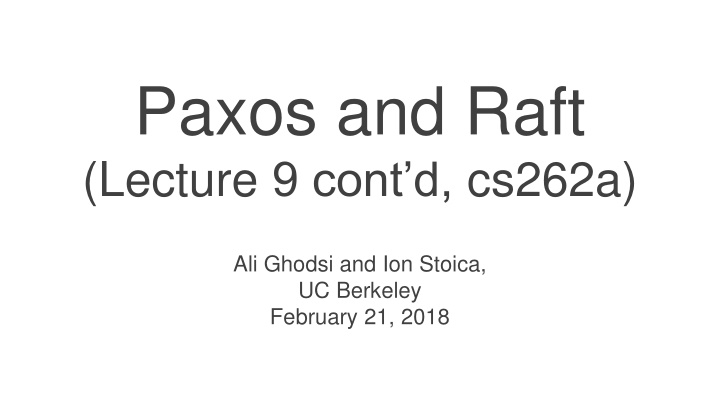
Direct Serialization Graph (DSG) & Isolation Models
Explore the concepts of Direct Serialization Graph (DSG), isolation models, and phenomena in distributed systems. Learn about mixing isolation levels, portable ANSI isolation levels, and essential consensus algorithms like Paxos and Raft.
Download Presentation

Please find below an Image/Link to download the presentation.
The content on the website is provided AS IS for your information and personal use only. It may not be sold, licensed, or shared on other websites without obtaining consent from the author. If you encounter any issues during the download, it is possible that the publisher has removed the file from their server.
You are allowed to download the files provided on this website for personal or commercial use, subject to the condition that they are used lawfully. All files are the property of their respective owners.
The content on the website is provided AS IS for your information and personal use only. It may not be sold, licensed, or shared on other websites without obtaining consent from the author.
E N D
Presentation Transcript
Paxos and Raft (Lecture 9 cont d, cs262a) Ali Ghodsi and Ion Stoica, UC Berkeley February 21, 2018
Direct Serialization Graph (DSG) Conflict Name Directly write-depends Directly read-depends Directly anti-depends Description T1 writes value, then T2 overwrites it T1 writes value, then T2 reads it T1 reads value, then T2 writes it DSG T1 T1 T1 T2 T2 T2 ww wr rw Example: T1:W(A), W(B), W(C) T2: T3: W(B) R(B), W(C) R(C), W(B) wr rw wr T1 T2 T3 ww ww
Phenomena G0 G0 DSG contains a directed cycle with ww edges G1 contains a directed cycle with ww and dependency cycles G2 contains a directed cycle with one or more anti- dependency edges G2-item: DSG contains a directed cycle having one or more item-anti dependency edges
Mixing of Isolation Levels Different transactions have different isolation levels MSG (Mixed Serialization Graph): contains only dependencies relevant to a transaction s level + obligatory conflict edges Transaction Ti has an obligatory conflict with transaction Tk if Tk is running at a higher level than Ti Ti conflicts with Tk conflict is relevant at Tk s level E.g., An anti-dependency edge from a PL-3 transaction to a PL-1 transaction is an obligatory edge since overwriting of reads matters at level PL-3
Todays Papers Paxos Made Simple, Leslie Lamport (research.microsoft.com/en-us/um/people/lamport/pubs/paxos-simple.pdf) In Search of an Understandable Consensus Algorithm, Diego Ongaro and John Ousterhout, USENIX ATC 14 (https://ramcloud.stanford.edu/raft.pdf) The Chubby lock service for loosely-coupled distributed systems, Mike Burrows, OSDI 06 (https://www.usenix.org/event/osdi osdi06/tech/full_papers/burrows/burrows.pdf )
Paxos Based on many slides from Indranil Gupta s presentation: (https://courses.engr.illinois.edu/cs525/sp2013/L9_paxos.sp13.ppt), and Gene Pang s presentation (www.cs.berkeley.edu/~istoica/classes/cs294/11/notes/07-gene-paxos.pptx)
Distributed consensus problem Group of processes must agree on a single value Value must be proposed After value is agreed upon, it can be learned
Two types of failures Non Non- -Byzantine Byzantine Failed nodes stop communicating with other nodes "Clean" failure Fail Fail- -stop stop behavior Byzantine Byzantine Failed nodes will keep sending messages Incorrect and potentially misleading Failed node becomes a traitor traitor Assumption: asynchronous, non-byzantine model
Consensus Impossibility Result Byzantine Generals Problem Why cannot reach consensus?
Paxos L. Lamport, The Part-Time Parliament, September 1989 Aegean island of Paxos A part-time parliament Goal: determine the sequence of decrees passed (consensus!)
Political Analogy Paxos has rounds: each round has a unique ballot ID Rounds are asynchronous Time synchronization not required If you are in round j and hear a message from round j+1, abort everything and go to round j+1 Each round Phase 1: A leader is elected (election) Phase 2: Leader proposes a value (bill), processes acks Phase 3: Leaders multicast final value (law)
Does Paxos Solve Consensus? Provides safety and liveness Safety: Only a value which has been proposed can be chosen Only a single value can be chosen A process never learns a value unless it was actually chosen Eventual liveness: If things go well at some point in the future (e.g., no longer losses or failures), consensus is eventually reached. However, this is not guaranteed.
So Simple, So Obvious In fact, it is among the simplest and most obvious of distributed algorithms. - Leslie Lamport
3 Types of Agents Proposers Acceptors Learners
Simple Implementation Typically, every process is acceptor acceptor, proposer proposer, and learner learner A leader leader is elected to be the distinguished proposer and learner Distinguishes proposes to guarantee progress Avoid dueling proposers Distinguishes learners to reduce too many broadcast messages
Recall Rounds are asynchronous Time synchronization not required If you are in round j and hear a message from round j+1, abort everything and move to round j+1 Each round consists of three phases Phase 1: A leader is elected (Election) Phase 2: Leader proposes a value, processes acks (Bill) Phase 3: Leader multicasts final value (Law)
Phase 1 Election Potential leader chooses a unique ballot ID, higher than anything it has seen so far Sends ballot ID to all processes Processes respond to highest ballot ID If potential leader sees a higher ballot ID, it can t be a leader Paxos tolerant to multiple leaders, but we ll mainly discuss only one leader case Processes also log received ballot ID on disk (why?) OK! Please elect me!
Phase 1 Election If majority (i.e., quorum) respond OK then you are the leader If no one has majority, start new round A round cannot have two leaders (why?) OK! Please elect me!
Phase 2 Proposal (Bill) Leader sends proposal value v to all If some process already decided value v in a previous round sends v = v Recipient log on disk, and responds OK Value v ok? OK! OK! Please elect me!
Phase 3 Decision (Law) If leader hears OKs from majority, it lets everyone know of the decision Recipients receive decisions, log it on disk Value v ok? v! OK! OK! Please elect me!
When is Consensus Achieved? Value v ok? v! OK! OK! Please elect me!
When is Consensus Achieved? When a majority of processes hear proposed value and accept it: Value v ok? v! OK! OK! Please elect me!
When is Consensus Achieved? When a majority of processes hear proposed value and accept it: Are about to respond (or have responded) with OK! At this point decision has been made even though Processes or even leader may not know! What if leader fails after that? Keep having rounds until some round complete Value v ok? v! OK! OK! Please elect me!
Safety Assume a round with a majority hearing proposed value v and accepting it (mid of Phase 2). Then subsequently at each round either: The round chooses v as decision The round fails Value v ok? v! OK! OK! Please elect me!
Safety Assume a round with a majority hearing proposed value v and accepting it (mid of Phase 2). Then subsequently at each round either: The round chooses v as decision The round fails Proof : Potential leader waits for majority of OKs in Phase 1 At least one will contain v (because two majority sets intersect) It will choose to send out v in Phase 2 Success requires a majority, and two majority sets intersects Value v ok? v! OK! OK! Please elect me!
Basic Paxos Protocol Phase 1a: Prepare Select proposal number* N and send a prepare(N) request to a quorum of acceptors. Phase 1b: Promise If N > number of any previous promises or acceptances, * promise to never accept any future proposal less than N, - send a promise(N, U) response (where U is the highest-numbered proposal accepted so far (if any)) Proposer Phase 2a: Accept! If proposer received promise responses from a quorum, - send an accept(N, W) request to those acceptors (where W is the value of the highest-numbered proposal among the promise responses, or any value if no promise contained a proposal) Acceptor Phase 2b: Accepted If N >= number of any previous promise, * accept the proposal - send an accepted notification to the learner * = record to stable storage
Trivial Example: P1 wants to propose A P1 A1 prepare(1) A2 prepare(1) L1
Trivial Example: P1 wants to propose A promise(1)promise(1) P1 A1 prepare(1) A2 prepare(1) L1
Trivial Example: P1 wants to propose A promise(1)promise(1) P1 A1 prepare(1) accept(1, A) A2 prepare(1) accept(1, A) L1
Trivial Example: P1 wants to propose A promise(1)promise(1) P1 A1 prepare(1) accept(1, A) A2 prepare(1) accept(1, A) L1 accepted(A) accepted(A)
Example P1 A1 prepare(1) A2 prepare(1) L1
Prepare Example P1 A1 Prepare(10) Highest Accept: (5, A) Highest Prepare: 15 A2 prepare(10) Highest Accept: (5, A) Highest Prepare: 8
Prepare Example Promise(10, (5, A)) P1 A1 Prepare(10) Highest Accept: (5, A) Highest Prepare: 15 A2 prepare(10) Highest Accept: (5, A) Highest Prepare: 8 Highest Accept: (5, A) Highest Prepare: 10
Simple Accept Example P1 Assume it got promise for 10 from a quorum A1 Highest Accept: (5, A) Highest Prepare: 15 accept(10, A) A2 Highest Accept: (5, A) Highest Prepare: 10 accept(10, A) L1
Simple Accept Example P1 Assume it got promise for 10 from a quorum A1 Highest Accept: (5, A) Highest Prepare: 15 accept(10, A) A2 Highest Accept: (5, A) Highest Prepare: 10 accept(10, A) L1 accepted(A)
Example: Livelock P1 P2 A1 A1: Highest accept; (5, A) Highest prepare: 8
Example: Livelock promise(10, (5, A)) P1 P2 A1 prepare(10) A1: Highest accept; (5, A) Highest prepare: 10
Example: Livelock promise(10, (5, A)) P1 Promise(11,(5, A)) P2 A1 prepare(10) prepare(11) A1: Highest accept; (5, A) Highest prepare: 11
Example: Livelock promise(10, (5, A)) P1 Promise(11,(5, A)) P2 A1 prepare(10) prepare(11) accept(10, A) A1: Highest accept; (5, A) Highest prepare: 11
Example: Livelock promise(10, (5, A)) promise(12, (5, A)) P1 Promise(11,(5, A)) P2 A1 prepare(10) accept(10, A) prepare(12) prepare(11) A1: Highest accept; (5, A) Highest prepare: 12
Example: Livelock promise(10, (5, A)) promise(12, (5, A)) P1 Promise(11,(5, A)) Promise(13,(5, A)) P2 A1 prepare(13) prepare(10) accept(10, A) prepare(12) prepare(11) A1: Highest accept; (5, A) Highest prepare: 13
Example: P1 want to propose value A P1 P2 A1 prep(5) A2 prep(5) A3 prep(5) L
Example: P1 want to propose value A prom(5) prom(5) P1 P2 A1 prep(5) A2 prep(5) A3 prep(5) L
Example: P1 want to propose value A prom(5) prom(5) P1 P2 A1 prep(5) accept(5, A) A2 prep(5) accept(5, A) A3 prep(5) accept(5, A) L
Example: P1 want to propose value A prom(5) prom(5) accepted(A) P1 P2 A1 prep(5) accept(5, A) A2 prep(5) accept(5, A) A3 prep(5) accept(5, A) L accepted(A)
prom(5, (3, C)) prom(5, (4, D)) prom(5, (2, B)) Example accepted(D) P1 P2 A1 prep(5) accept(5,D) A2 prep(5) accept(5, D) A3 prep(5) accept(5, D) L Accepted(D)



